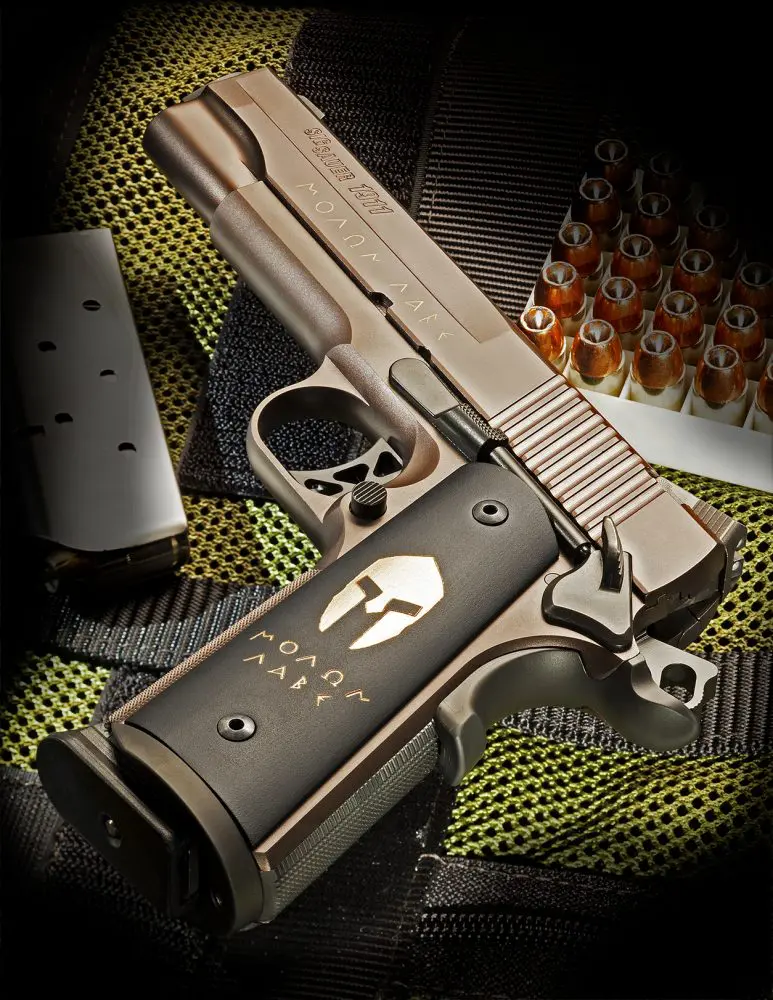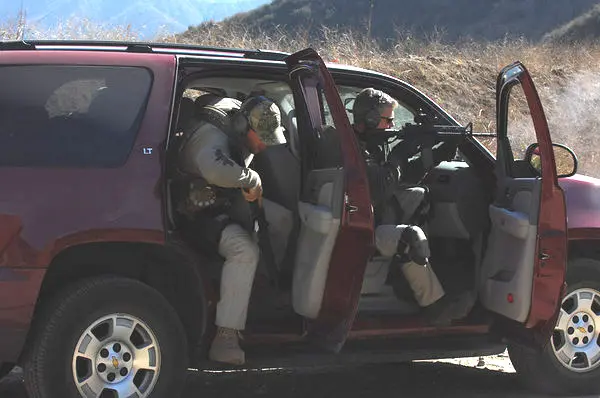
It occurred to me as I rumbled east from my home in coastal southern California to Chino Valley, Arizona that an 800-mile round trip just to test fire a couple of guns would probably be a bit much in most people’s opinion.However, we couldn’t ship the guns to my great state of Kalifornia without copious paperwork and clearances, so there I was, undeterred in my quest as the thermometer in my Suburban read 115 degrees when I crossed the Colorado River.
I was going to see my old friend Dave Lauck, proprietor of DL Sports, to shoot both his new custom Glocks and the subject of this report, his Professional Model Carbines. I’ve known Dave for almost 20 years, and one thing I’ve learned about the guy is that he just can’t leave well enough alone.
Actually, that is somewhat of a misstatement, because if it is “well enough,” he will leave it be. On the other hand, if there is something amiss with a product or procedure, it eats at him until he fixes it.
That’s what happened with the 1911 pistol, where many years of trying to work around poor starting stock finally led him to having his own frames custom-forged to his specifications—and then rejecting a good percentage of those because they didn’t meet his stringent quality-control inspection.
Table of Contents
PROFESSIONAL MODEL AR

Once he had the 1911 project all patted down and running smoothly, he turned his attention to the AR-15. Dave has had a long-running affair with the AR, going back to the 1970s, when he was sawing off the carry handles on the guns to achieve a proper low scope-mounting position.He has lived through the many iterations of the AR, not only building new versions as time has gone by, but also clearly documenting that process and things to come with a book that he and I co-wrote a few years ago, The Tactical AR-15, from the sadly now-defunct Paladin Press.
As with the 1911, the AR had/has some shortcomings, one of the most egregious being the bolt-over-base failure to feed where the bolt slips over the top of the cartridge rim on the feed stroke, tying up the gun. The most obvious cause of this malfunction is due to the magazine making a poor presentation of the cartridge to the alignment of the bolt.

Lauck redesigned the magazine follower and recontoured the magazine lips to correct this, and these have helped a lot. He manufactures and offers his own magazines, which are highly regarded by professional operators from all backgrounds—military, law enforcement, and competition.But the second half of that problem is in the design of the receiver feed ramp itself, which was not as easy to fix. There have been some changes to this area with the M4 carbine, but they stop short of a complete cure. So, like the 1911, Dave found himself committing to having his own receiver design produced—a complex and expensive project.
The good news is that Lauck’s version of the M4 feed ramp, combined with the improved posture of the top cartridge in the new magazines, make all the difference in the world when it comes to general reliability, and specifically when addressing the bolt-over-base issue.
Naturally, Dave didn’t stop there, and his Professional Model AR is a showcase of refinements and improvements when it comes to this gun. He will build you either a piston or direct-impingement gun, whichever you prefer.
Included in the package is an improved gas system for either design: Lauck’s forend that free-floats as much of the barrel as possible, his heavy-duty buttstock that absolutely protects the buffer and recoil spring, and a highly tuned trigger system that maintains full sear engagement to eliminate slack and trigger creep.
He sets those triggers at around five pounds for a safe duty application, although they are so smooth and crisp, it feels like much less.
Optics sit on a flat-top rail that is cantilevered out past the front of the receiver to provide additional mounting space and to give plenty of room for a long eye-relief Scout scope or forward-mounted red dot sight.
Out on the front end, you’ll find a DL Sports muzzle brake/flash hider that further mitigates the already light recoil of the .223/5.56 cartridge.
Having mentioned that, let me note that you may have your Professional Carbine chambered for either the civilian .223 round or the more generous dimensions of the milspec 5.56.
Just as I was taking in all the features of the DL Sports AR, Dave sprang a little surprise on me when he uncased the new DL Sports AK!
PROFESSIONAL MODEL AK
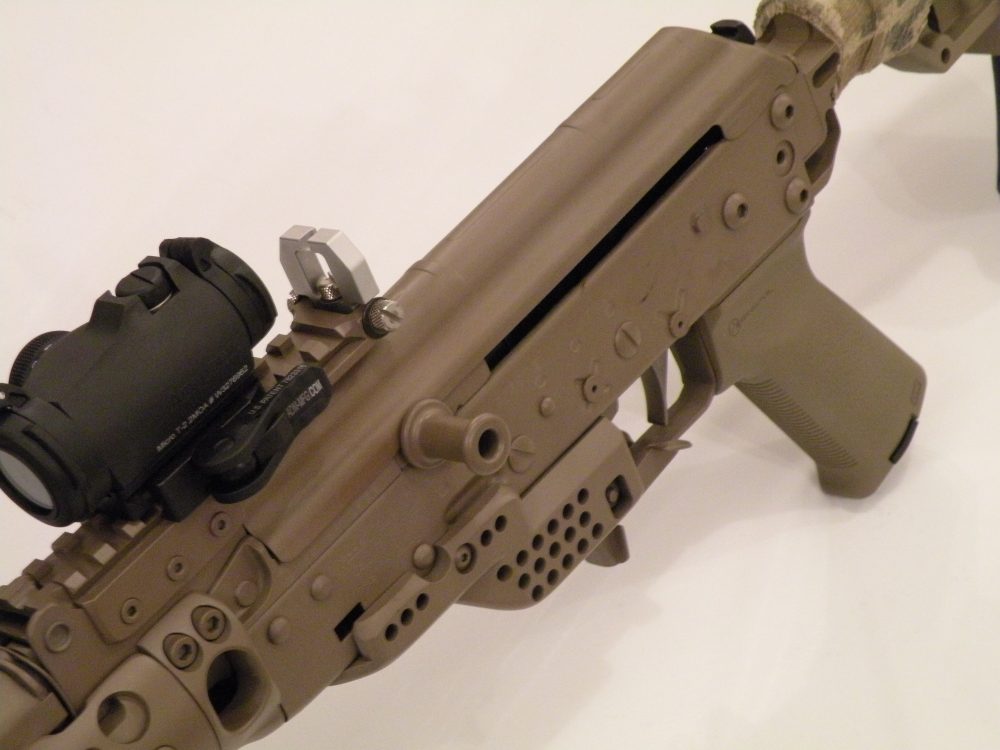
Whatever your personal feelings are about the AK, it is impossible not to respect the gun and the place it has held on battlefields around the world for many decades. Yes, it is much like handling a wood rasp that shoots, but its simplicity and reliability are legendary, and it is the tool of choice for much of the world.The modifications Dave has made to the AK are a definite upgrade in handling, utility, and accuracy, while he was very careful not to upset the reliable nature of the beast for which it is known.
Lauck’s first order of business was to “de-horn” the entire gun, smoothing and beveling all the sharp edges—of which there are many. That procedure alone makes a big difference when you handle the DL Sports AK, making it much easier on the hands—no need to upgrade gloves as a priority.
New furniture on the DL Sports AK begins with a unique adjustable buttstock that includes a spare magazine carrier and rubber buttplate.

The magwell is a major improvement, featuring deep, angled “wings” that guide the top of the magazine home during seating, and also having a new auxiliary release lever extending back along the trigger guard that is out of the way but can be operated without removing the control hand from the pistol grip.The safety also has a new tab positioned so it can be operated without altering the shooting grip. On top, a sight rail is firmly secured to the receiver itself rather than the loosely fitted dust cover. The forend free floats the barrel as much as possible and allows one to place rail mounts at 3, 6, and 9 o’clock for its entire length.

While the AR had a Leupold scope mounted on it, the AK wore a compact red dot sight with fold up/down back-up iron sights.These are custom units that Lauck produces, and the rear fixture is calibrated to exactly co-index with the red dot, so it really didn’t need to be folded down out of the way. In fact, I found it actually helped me to find the red dot and get on target faster.
Lauck has figured out how to improve the AK trigger, eliminating the excessively long and gritty travel, along with providing a snappy and positive reset that really makes a difference, especially during any kind of rapid fire.
Double or triple taps are lightning fast, and extended strings of rapid fire can be executed without having to consciously fling that trigger finger forward until it slaps the inside of the trigger guard to guarantee a full reset.

I’m not sure exactly what else he does to accomplish it, but accuracy is improved tremendously, even with ball ammo. The accompanying photo of the rapid-fire groups produced with the Hornady fodder really tells the story.This AK wore a DL Sports heavy-duty muzzle brake that reduces recoil and muzzle rise, and is designed to serve other purposes. The very end of the brake is configured with some sharp teeth that not only make it excellent for “direct personnel control” techniques, but also allow you to seat wire in the notches so you can quickly and positively cut barbed wire or shoot a hole in chain-link fencing.
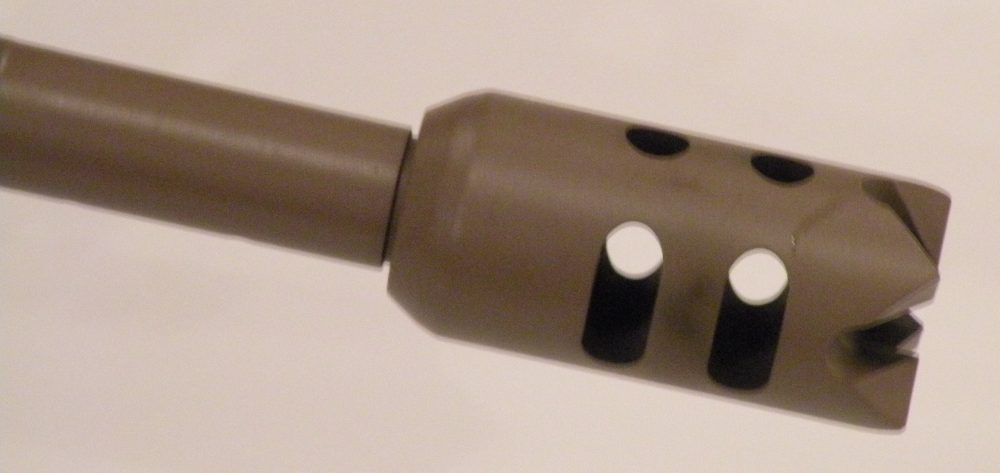
After I got to Dave’s shop and spent some time looking over all the features of the two carbines, we took a ride into the Arizona countryside.
DESERT SHOOT
It was a short jaunt to Dave’s shooting spot. After we got there, he hiked out some 50 long paces from the truck and set up the target stand with several two-inch orange pasters on a cardboard backing sheet.
I’d had surgery on both shoulders in the last 18 months, and this was the first time I’d fired a long gun since then, so I wasn’t at 100%. But both guns were lightweight, wore excellent sights, and had great triggers, so I didn’t embarrass myself to any great degree.

The AR was easy to get on target, something I don’t usually say about offhand shooting with a conventional scope. The superb trigger and effective muzzle brake teamed up to do their jobs and let me keep all my shots near the pasters and the majority of them on the orange circles.That’s about as well as I shoot when healthy, so it was clear that a better marksman could pretty easily chew the center out of one of those pasters from 50 yards.
The co-indexed rear iron sight on the AK let me quickly pick up the red dot. Quick snap shots easily found their way onto the orange targets.
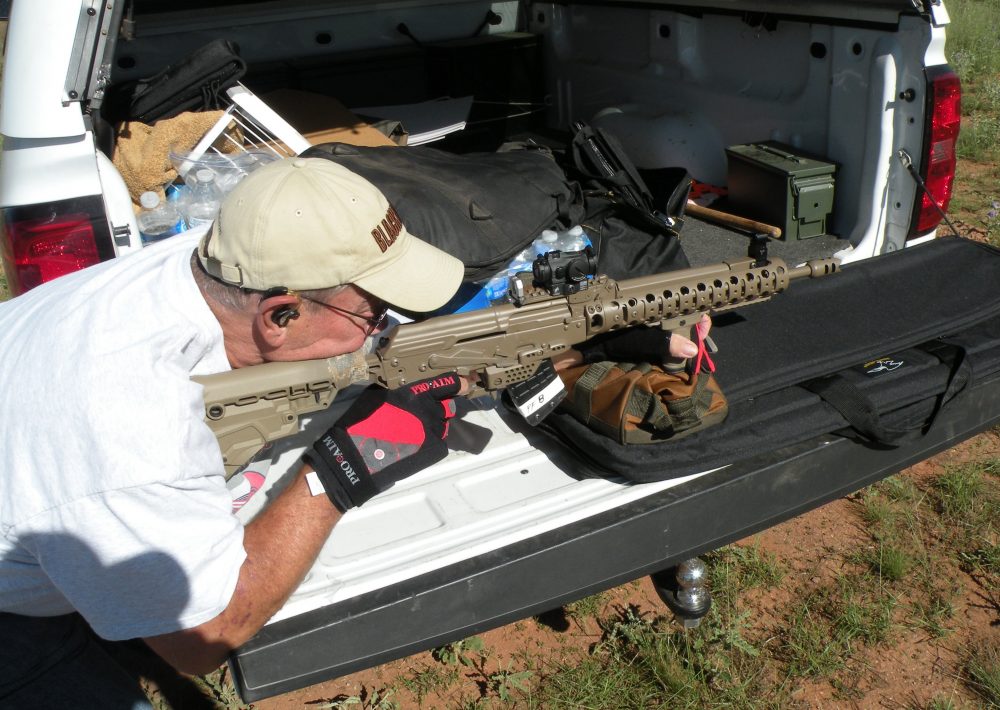
I took the AK over to the truck. Resting it on a bag laid out on the tailgate, I absolutely murdered that paster with my “Arizona Benchrest” technique.I put a little over 100 rounds through each carbine, the last half of which were fired up onto the backstop hillside, where I clobbered rocks down to the size of softballs with both carbines out to about 150 yards.
It was fun to knock one loose from the top of the hill and chase it as it rolled down. If I didn’t actually hit the rolling rock, I was always close enough to scare the hell out of it!
I began to get sore and a little tired after a couple hundred rounds, but I had seen and learned everything about the guns I had made the long trip to discover, so we called it a day.
If you’d like to see detailed specs or learn more about these guns, go to the DL Sports website.
SOURCE:
DL SPORTS
(928) 636-1726
www.dlsports.com

